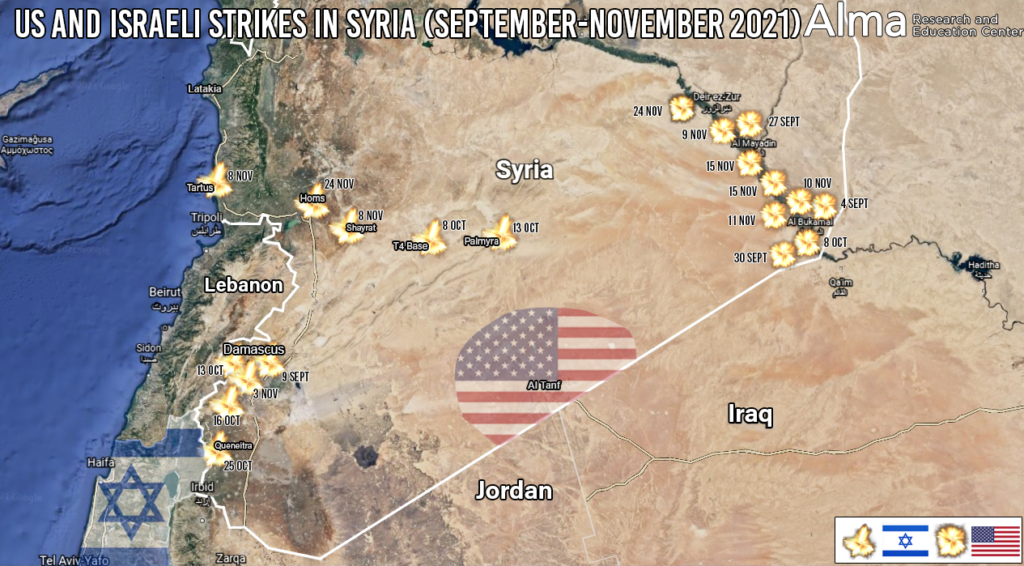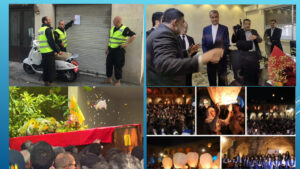In the last three months (September to November 2021), we were able to monitor at least ten “silent” airstrikes carried out against targets of the radical Shiite axis in the al-Bukamal area of eastern Syria. The al-Bukamal region is a strategic area within the land corridor of the radical Shiite axis headed by Iran. As a result, Iran’s military and civilian hold on the region is absolute.
These “quiet” airstrikes targeted vehicles, surface-to-surface missiles, headquarters, weapons depots, and military positions used by the radical Shiite axis. These airstrikes join the “noisier” airstrikes carried out against the radical Shiite axis targets in the Damascus, Palmyra, Homs, Latakia, and the Tartus areas. According to reports, these attacks are attributed to Israel.
These “quiet” attacks are usually carried out using low-signature weaponry (such as UAVs). The results of these attacks typically do not cause noise in the media. “Noisy” strikes are generally carried out by fighter jets and/or surface-to-surface missiles, and their results often resonate in the media.
In our assessment, there is an organized division of responsibility between the United States and Israel for attacking targets related to the activities of the radical Shiite axis headed by Iran in Syria. In every sector, the purpose of the attacks is different.
The “quiet” sector (“The American sector”) is geographically defined within eastern Syria and includes al-Bukamal, al Mayadin, and Deir ez-Zor.
Attacks within this sector are the responsibility of The United States. The main objective of the attacks in this sector is meant to disrupt the entrenchment of Iranian-linked forces near the land corridor route.
The “noisy” sector (“The Israeli sector”) is geographically defined within the central, northern, and western parts of Syria, focusing on the Damascus area, the Palmyra area – Homs, and the Latakia-Tartus region. Attacks within this sector are the responsibility of Israel. The main objective of the attacks in this area is to strike special weapons and prevent them from being transferred to Hezbollah in Lebanon (precision missiles, Iranian surface-to-air missile systems, air defense systems, UAVs, cruise missiles, etc.).
In our assessment, there is also likely to be quite a lot of Israeli activity in the “American sector” in eastern Syria.
In addition to the two sectors above, there is another geographically defined sector adjacent to the Israeli border in southern Syria. This sector also falls under “Israeli responsibility,” the objective of its offensive activity in this sector is mainly to cause harm to terrorist infrastructures established there by Hezbollah (the “Southern Command” and the “Golan File” units).
We have several indications showing attempts by the radical Shiite axis to minimize damage. On November 10, a meeting was held between the leaders of the Shiite militias and their Iranian Revolutionary Guards mentors and Russian commanders at the T4 base located between Palmyra and Homs. Members of the radical Shiite axis urged the Russians to try to rein in Israeli attacks or at the very least establish Iranian and Russian joint bases. The Russians refused, noting that it was vital for them to maintain the independence of their forces in Russia. The Russians agreed to military cooperation only in the context of fighting ISIS.
At the same time, the Shiite militias in eastern Syria and the border area with Iraq began removing identifying Iranian signs from their headquarters and replacing them with the Syrian regime flag. In addition, we are witnessing the transfer of armaments from place to place, hiding them in new sites. The Iranians also asked representatives of the Syrian army to ensure that there would be no significant Syrian forces activity near the bases associated with the Shiite axis to make intelligence surveillance more difficult.
According to reports from November 21, the Iranian Revolutionary Guards are continuing to vacate equipment from the T4 airport to the Shayrat airport near Homs. The extent of the evacuation of the equipment from the airport is unclear, and it is also unclear what the Iranian intentions are for their continued presence there.
The Iranian UAV attack on the American base in al-Tanf on October 20 (from which 200 soldiers were evacuated in advance) came in response to the close offensive cooperation between the United States and Israel against targets of the radical Shiite axis in Syria. The purpose of the attack was to send an Iranian message to both the United States and Israel: Iran reserves the right to retaliate against both the United States and Israel, regardless of which of the two attacked them in Syria.
Rocket attacks against American bases in northeastern Syria are also part of the radical Shiite axis’ response. The last of which occurred on 23 November. Five rockets were apparently fired by Shiite militias at “Harab al-Jair” military airport, which serves as a U.S. base in the Hasqa (الحسكة ) region of northeastern Syria.
List of Attacks
Attributed to the USA
4 Sept 2021 – Syria Iraq Border – 3 killed further number explosions
27 Sept 2021 – farmlands of Al Mayadin – 12 explosions?
30 Sept 2021 – Al Bukamal near the border –
8 October 2021 – Aisha hospital Al Bukamal
11 October 2021 – Al Bukamal near the border – 1 Syrian and for foreigners killed
9 November 2021 – N/A
10 November 2021 – 7 killed, at least 3 of them Syrian
15 November 2021 – N/A
15 November 2021 – N/A
Attributed to Israel
03/09 – Damascus area
08/10 – T4 Field
13/10 – Attack near Tadmor (Palmyra)
16/10 – Southern Syria: Elimination of the Saleh Madhat in Ein Athina near Khachar
25/10 – Southern Syria: Attack in the area of the state of El Ba’at – Tel Al-Krum.
10/30 – West of Damascus (south of Qura al-Assad)
03/11 – South of Damascus near the town of Zakia.
08/11 – The airport in Sharia (south of Homs) and in the Tartus area.
17/11 – South of Damascus.
24/11 – Attack near the city of Homs
24/11 – West of Deir ez-Zur, a drone hit a vehicle and killed two Hezbollah Iraq members, and injured two others.






